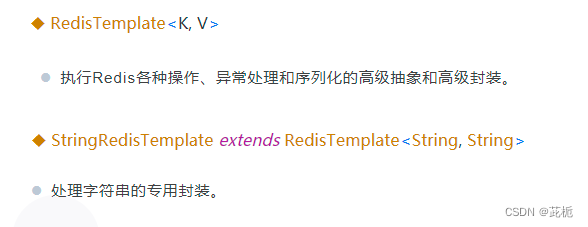spring boot-Spring Boot 使用 Redis
推荐 原创1,Spring 是如何集成Redis的?
首先我们要使用jar包
<dependency>
<groupId>org.springframework.boot</groupId>
<artifactId>spring-boot-starter-data-redis</artifactId>
</dependency>
<dependency>
<groupId>org.apache.commons</groupId>
<artifactId>commons-pool2</artifactId>
</dependency>2,我们使用的时候需要用到高级封装

2,配置Redis
# Redis服务器地址
spring.redis.host=10.1.30.222
# Redis数据库索引(默认为0)
spring.redis.database=0
# Redis服务器连接端口
spring.redis.port=6379
# Redis服务器连接密码(默认为空)
#spring.redis.password=
## 连接超时时间(毫秒)
spring.redis.timeout=30000
# 连接池最大连接数(使用负值表示没有限制) 默认 8
spring.redis.lettuce.pool.max-active=8
# 连接池中的最大空闲连接 默认 8
spring.redis.lettuce.pool.max-idle=8
# 连接池中的最小空闲连接 默认 0
spring.redis.lettuce.pool.min-idle=1
#连接池中最大空闲等待时间,3s没有活干的时候直接驱逐该链接
spring.redis.lettuce.pool.min-evictable-idle-time-millis = 3000
# 连接池最大阻塞等待时间(使用负值表示没有限制) 默认 -1
spring.redis.lettuce.pool.max-wait=-1StringRedisTemplate
String
public class StringDemo {
@Autowired
private StringRedisTemplate stringRedisTemplate;
private final String key = "zhengzhou";
public void test() {
stringRedisTemplate.opsForValue().set(key, "我的家乡", 30, TimeUnit.SECONDS);
String value = stringRedisTemplate.opsForValue().get(key);
System.out.println(value);
}
}
Java
Hash
@Component
public class HashDemo {
@Autowired
private StringRedisTemplate stringRedisTemplate;
private final String key ="zhouxingxing";
public void test(){
stringRedisTemplate.opsForHash().put(key,"20220325","郑州");
stringRedisTemplate.opsForHash().put(key,"20220326","洛阳");
List<Object> values = stringRedisTemplate.opsForHash().values(key);
for (Object value:values){
System.out.println(value);
}
}
}
Java
List
@Component
public class ListDemo {
@Autowired
private StringRedisTemplate stringRedisTemplate;
private final String key ="onewayroad";
void test(){
stringRedisTemplate.opsForList().leftPush(key,"周星星");
stringRedisTemplate.opsForList().leftPush(key,"张敏");
stringRedisTemplate.opsForList().leftPush(key,"李大锤");
String value = stringRedisTemplate.opsForList().rightPop(key);
System.out.println(value);
}
}
@Test
void test6() {
// 如果一些原生命令,spring 没有给我们封装,redisTemplate.execute(new RedisCallback)
while (true){
System.out.println("开始一轮监听");
List<byte[]> rawResults = redisTemplateProduct.execute(new RedisCallback<List<byte[]>>() {
@Override
public List<byte[]> doInRedis(RedisConnection connection) throws DataAccessException {
return connection.bRPop(5,"product.hot".getBytes());
}
});
if(ObjUtil.isNotEmpty(rawResults)){
byte[] rawKey = rawResults.get(0);
byte[] rawValue = rawResults.get(1);
Product product = (Product)redisTemplateProduct.getValueSerializer().deserialize(rawValue);
System.out.println(product);
}
}
Java
Set
@Component
public class SetDemo {
@Autowired
private StringRedisTemplate stringRedisTemplate;
private final String zhouxingxing ="zhouxingxing";
private final String zhangmin = "zhangming";
public void test(){
//添加周星星同学感兴趣的科目
stringRedisTemplate.opsForSet().add(zhouxingxing,"语文");
stringRedisTemplate.opsForSet().add(zhouxingxing,"数学");
stringRedisTemplate.opsForSet().add(zhouxingxing,"数学");
//添加张敏同学感兴趣的科目
stringRedisTemplate.opsForSet().add(zhangmin,"数学");
stringRedisTemplate.opsForSet().add(zhangmin,"英语");
//获取两位同学共同感兴趣的科目
Set<String> values = stringRedisTemplate.opsForSet().intersect(zhouxingxing, zhangmin);
System.out.println("周星星和张敏共同感兴趣的科目为:");
for(String value : values){
System.out.println(value);
}
}
}
Java
ZSet
@Component
public class ZSetDemo {
@Autowired
private StringRedisTemplate stringRedisTemplate;
private final String key ="zhouxingxing";
public void test(){
//添加周星星同学成绩
stringRedisTemplate.opsForZSet().add(key,"语文",98);
stringRedisTemplate.opsForZSet().add(key,"数学",87);
stringRedisTemplate.opsForZSet().add(key,"英语",75);
//获取分数最高的成绩
ZSetOperations.TypedTuple<String> values = stringRedisTemplate.opsForZSet().popMax(key);
//打印值
System.out.println("周星星最好成绩科目是:"+values.getValue());
System.out.println("周星星最好成绩:"+values.getScore());
}
}
Java
BitMap
@Component
public class BitMapDemo {
@Autowired
private StringRedisTemplate stringRedisTemplate;
private final String key ="sign#2022#zhouxingxing";
public void test(){
//设置签到
stringRedisTemplate.opsForValue().setBit(key,2,true);
stringRedisTemplate.opsForValue().setBit(key,85,true);
//获取周星星同学的签到天数
RedisCallback<Long> callback = connection -> { return connection.bitCount(key.getBytes(),0,365);};
Long count = stringRedisTemplate.execute(callback);
//打印周星星2022年签到天数
System.out.println("周星星2022年一共签到天数:"+count);
}
}
Java
3.RedisTemplate
3.1泛型约束的使用
@Component
public class RedisTemplateDemo {
@Autowired
private StringRedisTemplate stringRedisTemplate;
@Autowired
private RedisTemplate<String, String> redisTemplate_string_string;
@Resource
private RedisTemplate<String, User> redisTemplate;
@Resource(name="redisTemplate")
private ValueOperations<String,User> valueOperations;
private final String key = "useris#01";
public void test() {
User user = User.builder().id(1).name("李四").build();
redisTemplate.opsForValue().set(key,user );
User value = redisTemplate.opsForValue().get(key);
valueOperations.set(key,user );
User value2 = valueOperations.get(key);
System.out.println(value);
}
}
4,乱码的问题
JdkSerializationRedisSerializer serializer = new JdkSerializationRedisSerializer();
byte[] serialize = serializer.serialize("user#01");
System.out.println(new String(serialize));
自定义序列化工具
@Configuration
public class RedisConfig {
@Bean //主动注册了一个名字叫redisTemplate 的bean
public RedisTemplate<Object, Object> redisTemplate(RedisConnectionFactory redisConnectionFactory)
{
RedisTemplate<Object, Object> template = new RedisTemplate<>();
template.setConnectionFactory(redisConnectionFactory);
Jackson2JsonRedisSerializer jackson = new Jackson2JsonRedisSerializer(Object.class);
ObjectMapper mapper = new ObjectMapper();
// 启用默认类型推理,将类型信息作为属性写入JSON
// 就是把对象的全类名写入json
mapper.activateDefaultTyping( mapper.getPolymorphicTypeValidator(), ObjectMapper.DefaultTyping.NON_FINAL);
jackson.setObjectMapper(mapper);
template.setKeySerializer(StringRedisSerializer.UTF_8);
template.setValueSerializer(jackson);
template.setHashKeySerializer(StringRedisSerializer.UTF_8);
template.setHashValueSerializer(jackson);
return template;
}
}为什么要自定话应该序列化工具,因为他自己提供的不是很好,所以我们要自己定义一个,这样的话可以把java对象转化成json和字节码存入Redis 里,反序列化就是把json和字节码转化为java对象,泛型指定为
Object.class表示可以处理任何类型的对象。最后返回配置好的
RedisTemplate实例,这样在整个Spring Boot应用中,当需要使用RedisTemplate进行操作时,将自动使用这个经过JSON序列化配置的模板。
详细的介绍:
-
@Configuration注解表明这是一个配置类,Spring IoC容器将会读取该类中的bean定义。 -
@Bean注解的方法表示该方法会返回一个对象,该对象会被注册为Spring容器中的bean。在这个例子中,方法名为redisTemplate,所以生成的bean的名字也是 "redisTemplate"。 -
方法体中首先创建了一个
RedisTemplate<Object, Object>实例,并将其连接工厂设置为传入的RedisConnectionFactory,这是连接Redis的基础配置。 -
创建了
Jackson2JsonRedisSerializer实例,用于将Java对象序列化为JSON字符串,反序列化时则将JSON字符串转回为Java对象。泛型指定为Object.class表示可以处理任何类型的对象。 -
初始化
ObjectMapper,它是Jackson库中用于处理JSON的核心类。这里启用了默认类型推理(activateDefaultTyping),这样在序列化时,即使目标类没有显式地声明类型信息,也能根据实际运行时类型推断并在JSON中包含类型信息,这对于处理多态类型的场景非常有用。 -
将初始化好的
ObjectMapper设置给Jackson2JsonRedisSerializer。 -
配置RedisTemplate的序列化策略:
template.setKeySerializer(StringRedisSerializer.UTF_8);设置键(key)的序列化器为StringRedisSerializer,以UTF-8格式进行字符串序列化。template.setValueSerializer(jackson);设置值(value)的序列化器为刚才创建的Jackson2JsonRedisSerializer,即所有值都将转化为JSON字符串存储。template.setHashKeySerializer(StringRedisSerializer.UTF_8);设置哈希表键(hash key)的序列化器也为StringRedisSerializer,同样以UTF-8格式进行字符串序列化。template.setHashValueSerializer(jackson);设置哈希表值(hash value)的序列化器为Jackson2JsonRedisSerializer,意味着哈希表中的每个值也将被转化为JSON字符串存储。
最后,返回配置好的 RedisTemplate 实例,这样在整个Spring Boot应用中,当需要使用RedisTemplate进行操作时,将自动使用这个经过JSON序列化配置的模板。
更多【spring boot-Spring Boot 使用 Redis】相关视频教程:www.yxfzedu.com
相关文章推荐
- 物联网-基于STM32的设计智慧超市管理系统(带收银系统+物联网环境监测) - 其他
- python-【Python基础】 Python设计模式之单例模式介绍 - 其他
- 物联网-物联网对接协议 - 其他
- 安全-远程运维用什么软件?可以保障更安全? - 其他
- 阿里云-STM32G0+EMW3080+阿里云飞燕平台实现单片机WiFi智能联网功能(三)STM32G0控制EMW3080实现IoT功能 - 其他
- 前端框架-vue项目中页面遇到404报错 - 其他
- 安全-vivo 网络端口安全建设技术实践 - 其他
- 前端框架-前端框架Vue学习 ——(五)前端工程化Vue-cli脚手架 - 其他
- 物联网-ZZ038 物联网应用与服务赛题第D套 - 其他
- 爬虫-网络爬虫的实战项目:使用JavaScript和Axios爬取Reddit视频并进行数据分析 - 其他
- c语言-ZZ038 物联网应用与服务赛题第C套 - 其他
- c语言-cordova Xcode打包ios以及发布流程(ionic3适用) - 其他
- 物联网-Xcode15 framework ‘CoreAudioTypes‘ not found - 其他
- 科技-打造高效运营底座,极智嘉一体化软件系统彰显科技威能 - 其他
- golang-深入剖析Golang中单例模式 - 其他
- 网络-工业自动化工厂PLC远程控制网关物联网应用 - 其他
- react.js-React Native自学笔记 - 其他
- android-【Android】Lombok for Android Studio 离线插件 - 其他
- android-Android Studio新建项目下载依赖慢,只需一个操作解决 - 其他
- 后端-使用 Ruby 的 Nokogiri 库来解析 - 其他
2):严禁色情、血腥、暴力
3):严禁发布任何形式的广告贴
4):严禁发表关于中国的政治类话题
5):严格遵守中国互联网法律法规
6):有侵权,疑问可发邮件至service@yxfzedu.com
